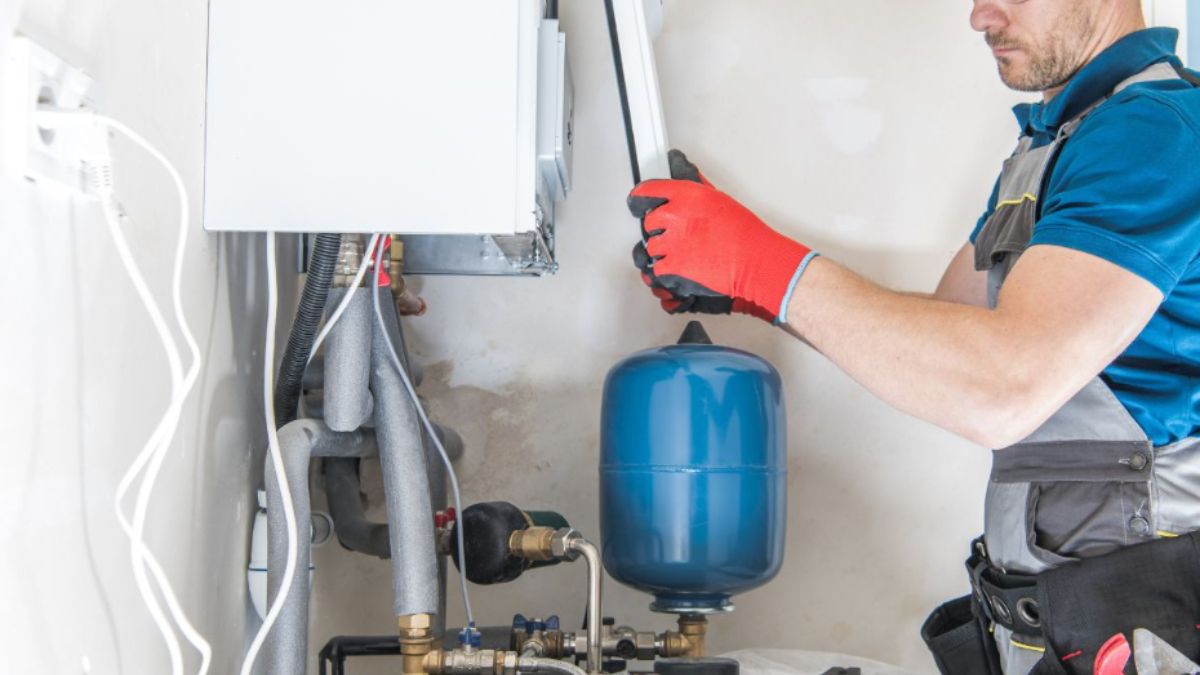TOPIC
You Might Need to Replace Your Water Heater

Replacing your water heater might sound like a big, intimidating task, but with the right knowledge and a solid plan, it can be a smooth and rewarding experience. Whether you’re replacing an old tank water heater or upgrading to a modern tankless system, this water heater replacement guide will equip you with all the essential information. From understanding the different types of water heaters to navigating the installation process, this guide will make sure you’re prepared for every step—whether you decide to tackle the project yourself or bring in a professional plumber. Let’s dive in and make this essential home improvement both easy and efficient!
Why You Might Need to Replace Your Water Heater
Before diving into the replacement process, it’s important to understand why your water heater might need replacement. Common reasons include:
- Age: Traditional water heaters typically last 10-15 years. If yours is nearing or exceeding this age, it’s probably time for a replacement.
- Leaks: Water pooling around the base of the heater often signals a leak that cannot be repaired.
- Rust or Sediment Buildup: If your water heater produces rusty or discolored water, it’s a sign of internal corrosion or sediment buildup.
- Inefficiency: If your unit is no longer providing sufficient hot water or is using more energy than usual, a replacement may be necessary.
Step 1: Choose Your New Water Heater
The first step in replacing a water heater is deciding which type to install. You can choose between a traditional tank water heater or a more modern tankless option.
- Tank Water Heater: These are the most common type of water heater. They store hot water in a tank and supply it as needed.
- Tankless Water Heater: This type heats water on demand, providing an endless hot water supply while saving space and energy. It’s ideal for smaller homes or those with high water usage needs.
Once you’ve decided which system works best for your needs, make sure to select a unit with the correct capacity. A water heater that’s too small won’t meet your needs, while a unit that’s too large may waste energy.
Step 2: Turn Off the Power and Water Supply
Before you start the replacement process, ensure safety by turning off the power supply to the water heater. If you have an electric water heater, switch off the breaker at your electrical panel. For gas water heaters, turn off the gas supply valve.
Next, turn off the water supply to the heater by closing the shutoff valve, which is usually located near the top of the tank. It’s important to release any pressure in the system before proceeding.
Step 3: Drain the Water Heater
Draining your old water heater is crucial to avoid spills and to prepare the unit for removal. Connect a garden hose to the drain valve at the bottom of the tank, and direct it to a nearby floor drain or outside. Open the valve and allow the tank to empty completely. You may need to open the pressure relief valve to help the water drain more easily.
Step 4: Disconnect the Old Water Heater
Once the tank is drained, disconnect the water heater from the plumbing and electrical connections. For electric units, disconnect the wiring by removing the access panel at the top of the unit. For gas units, disconnect the gas line using a wrench. Always check for any gas leaks before proceeding.
After the connections are safely disconnected, you can remove the old water heater from its position. This step may require some assistance, as water heaters can be heavy.
Step 5: Prepare the Space for the New Water Heater
Before installing the new unit, take a moment to inspect the area where the old heater was located. Ensure the space is clear of debris and that all connections are accessible. If you are switching from a tank water heater to a tankless system, you may need to make adjustments to the plumbing, ventilation, or electrical setup.
Step 6: Install the New Water Heater
- For Tank Water Heaters: Start by positioning the new unit in place. Connect the cold water supply pipe to the inlet and the hot water pipe to the outlet on the top of the tank. Tighten all fittings securely to prevent leaks. Once the plumbing connections are complete, connect the electrical or gas supply.
- For Tankless Water Heaters: Install the tankless unit according to the manufacturer’s instructions. These units often require a larger gas line or a dedicated electrical circuit. Make sure to install the necessary venting system for proper exhaust.
Step 7: Test the New Water Heater
Once your new water heater is installed, it’s time to test the system. Turn on the water supply and check for leaks around all connections. For electric models, turn the power back on, and for gas models, open the gas valve and relight the pilot light if needed. Set the thermostat to your desired temperature and allow the system to fill with water.
It may take some time for the unit to heat up the water fully, so be patient. Once the water reaches the set temperature, check the system again for proper functionality and make sure there are no leaks.
Step 8: Clean Up and Dispose of the Old Heater
Once you’ve confirmed that the new unit is working properly, clean up the installation site and dispose of the old water heater. Contact a local recycling center to ensure that the unit is disposed of properly.
DIY Water Heater Replacement vs. Professional Installation
While DIY water heater replacement is an option for some homeowners, there are a few things to keep in mind before proceeding with the replacement yourself:
- Skills and Tools: Installing a new water heater requires specialized knowledge, tools, and experience. Incorrect installation can result in leaks, water damage, or unsafe conditions.
- Local Codes and Permits: Depending on your area, you may need a permit for the installation. Be sure to check with local authorities.
- Safety: Gas lines and electrical systems require specialized training to handle safely.
If you are unsure or uncomfortable with any part of the installation process, hiring a professional plumber is always a safe option.
Replacing a water heater is a manageable project for homeowners who are comfortable with DIY tasks, but it requires attention to detail and strict adherence to safety procedures. Whether you are replacing an old water heater with a more energy-efficient model or switching to a tankless unit, following this step-by-step guide will help you achieve a successful installation. If you’re ever in doubt, don’t hesitate to reach out to a professional plumber to ensure the job is done correctly.
Recommended SEO Title: Step-by-Step Guide to Replacing Your Water Heater: A Complete DIY and Professional Installation Guide
Recommended Meta Description: Discover how to replace your water heater with this detailed step-by-step guide. Whether you’re installing a tank or tankless system, get expert tips for success.
Recommended Featured Snippet: Replacing a water heater involves turning off the power and water supply, draining the tank, disconnecting old plumbing, and installing the new unit. Always test the system before disposing of the old water heater.
Recommended H1 Tag:
Step-by-Step Guide to Replacing Your Water Heater
TOPIC
Top Strategies for Success in Pokedle: Tips from the Pros

Introduction to Pokedle
Welcome to the vibrant world of Pokedle, where strategy meets fun in an exhilarating adventure! If you’re new to this captivating game or looking to sharpen your skills, you’re in for a treat. Pokedle combines elements of exploration and competition that keep players coming back for more. With its unique creatures and challenging battles, it’s no wonder that fans are eager to uncover what makes this game so addictive.
Whether you aim to become a top contender or just want to enjoy the gameplay with friends, mastering the nuances of Pokedle is essential. In this blog post, we’ll explore some tried-and-true strategies from seasoned players that can elevate your gaming experience. Let’s dive into the essentials and unlock your potential as a true Pokedle master!
Understanding the Basics: Types, Elements, and Moves
Pokedle is a vibrant world filled with diverse creatures, each possessing unique abilities. Understanding the different types of Pokedle is crucial for effective gameplay. There are elemental categories like Fire, Water, Grass, and Electric. Each element has strengths and weaknesses that can turn the tide in battles.
Elements determine how Pokedle interact during combat. For example, Water-type moves are super effective against Fire-types but weak against Electric-types. Knowing these interactions will help you make strategic decisions.
Moves play a significant role too. Every Pokedle can learn various attacks. Some may deal heavy damage while others focus on status effects like paralysis or sleep.
Understanding these components creates a solid foundation for any aspiring trainer looking to excel in the game and build powerful strategies around their team composition.
Building Your Team: Choosing the Right Pokedle for You
Choosing the right Pokedle is crucial for your success. Each type comes with its strengths and weaknesses. Assess what fits your play style best.
Consider the elemental types first. Water, fire, grass—each element has unique advantages in battles. Think about how they might counter opponents’ choices.
Next, evaluate movesets. Some Pokedles excel at dealing damage while others focus on support or defense strategies. A balanced team often yields better results.
Don’t forget about synergy between team members. Combining different elements can create powerful combinations that catch opponents off guard.
Experimentation is key here. Try multiple configurations to discover which Pokedles resonate with you personally and enhance your gameplay experience.
A well-rounded team tailored to your preferences sets the stage for victory in every match you encounter on this thrilling journey.
Training and Evolving Your Pokedle
Training your Pokedle is essential for unlocking its full potential. Each Pokedle has unique traits and abilities that can be enhanced through proper training methods.
Start with daily battles to gain experience points. The more you battle, the stronger your Pokedle becomes. Pay attention to its moves; some are best suited for offensive strategies while others excel in defense.
Evolving your Pokedle opens new avenues of gameplay. To evolve effectively, focus on leveling up through various challenges and quests. Certain items may also trigger evolution, so keep an eye out for those valuable resources.
Don’t forget about friendship levels! Some Pokedles evolve when they reach a high bond with you. Spend quality time together by participating in mini-games or simply exploring new areas side by side.
Balancing these elements will help shape a formidable team ready for any challenge ahead.
Battling Techniques: Using Strategy and Tactics
In Pokedle, battles are not just about raw power. Strategy and tactics play a crucial role in securing victory. Understanding your opponent’s weaknesses gives you an edge.
Timing is essential when executing moves. Knowing when to attack or defend can turn the tide in your favor. A well-timed move may catch your opponent off guard, leading to unexpected outcomes.
Positioning matters too. Placing your Pokedle correctly on the battlefield maximizes its abilities while minimizing damage taken from foes. Always be aware of both yours and your enemy’s positioning.
Using status effects can disrupt opponents’ strategies effectively. Inflicting paralysis or sleep might give you that critical moment needed for a decisive blow.
Stay adaptable during battles. If a strategy falters, don’t hesitate to switch gears and try something new based on real-time observations of the battle flow.
Tips from Professional Players
Professional players emphasize the importance of understanding your Pokedle’s strengths and weaknesses. Each type has its own advantages, so knowing them can turn the tide in battles.
Timing is crucial. Pro players often recommend practicing with different moves to find the best moment to strike. Patience can lead to perfect execution when it counts.
Another tip is to analyze your opponent’s strategy during a match. Observing their patterns allows you to anticipate their next move, giving you an edge in tight situations.
Team synergy cannot be overlooked either. Pros suggest building a well-rounded team that complements each member’s abilities for maximum effectiveness.
Never underestimate practice sessions. Regular training helps refine techniques and boosts confidence when facing real opponents in competitive scenarios.
Conclusion: Mastering Pokedle for Victory
Mastering Pokedle takes dedication, strategy, and a deep understanding of the game’s mechanics. By grasping the various types and elements of Pokedle, players can build strong teams that complement each other. Training your Pokedle effectively ensures they reach their full potential.
Utilizing smart battling techniques allows you to turn the tide in challenging matches. Learning from seasoned professionals will provide insights that can elevate your gameplay significantly.
As you navigate this journey, keep experimenting with different strategies and approaches. The world of Pokedle is vast and exciting, waiting for you to explore its depths. With persistence and passion, victory in Pokedle is well within your reach. Embrace the adventure wholeheartedly!
TOPIC
Why the 404 Area Code is More Than Just a Dialing Prefix for Atlantans

The 404 area code isn’t just a series of numbers—it’s a symbol of identity, culture, and community for Atlantans. When you hear that familiar dialing prefix, it evokes images of bustling streets, rich history, and vibrant neighborhoods. But there’s so much more to this area code than meets the eye. From its intriguing past to its present-day significance in technology and business, the 404 area code is woven into the fabric of Atlanta life. Join us as we explore what makes this iconic number a true representation of everything that makes Atlanta special.
The History of the 404 Area Code
The 404 area code was established in 1947, making it one of the original area codes assigned by AT&T. It initially covered a vast region, including much of Georgia and parts of Alabama.
As Atlanta grew rapidly during the mid-20th century, so did its need for more telephone numbers. The city blossomed into a major cultural and economic hub, prompting the creation of additional area codes over time.
By 1992, as population density increased further, the neighboring 678 and later 470 codes emerged to accommodate demand. Despite these changes, the nostalgia attached to the original 404 remains strong among longtime residents.
The early days of this area code were characterized by rotary phones and party lines—a far cry from today’s instant connectivity. Yet that history laid down roots that still resonate with Atlantans who cherish their city’s rich past.
The Expansion of the 404 Area Code
The 404 area code was established in 1947, covering just a small section of Georgia. Initially, it served only the Atlanta metropolitan area. As the city grew, so did its need for more communication channels.
By the mid-1990s, rapid population growth and technological advancements put pressure on this single area code. New areas were emerging across Greater Atlanta, leading to an expansion that affected local residents and businesses alike.
In response to increasing demand, officials introduced new codes like 678 and later 470. These additions helped ease congestion but also marked a shift in how people identified with their regional codes.
Despite these changes, many Atlantans still hold onto their original 404 numbers with pride. It’s become a badge of honor—a connection to the heart of Georgia’s vibrant culture and history amidst all that transformation.
What Makes the 404 Area Code Unique
The 404 area code is more than just a series of numbers. It carries the spirit and vibrancy of Atlanta, Georgia. This code originally encompassed the entire state but has evolved to represent the heart of the city.
Its uniqueness lies in its rich cultural tapestry. The 404 symbolizes a blend of history, music, and innovation that defines Atlanta’s identity. From hip-hop legends to culinary pioneers, this area code has nurtured iconic figures.
Moreover, it stands out through community pride. Locals proudly claim their connection to the 404 as part of their identity. It’s not uncommon to see “404” emblazoned on clothing or merchandise as a badge of honor.
In a world where many places share similar area codes, 404 serves as an emblem for Atlantan resilience and creativity—qualities that continue to shape the city’s narrative today.
Famous Companies and Landmarks Associated with the 404 Area Code
The 404 area code is a badge of honor for Atlanta, home to numerous iconic companies and landmarks. Coca-Cola’s global headquarters sits proudly in the heart of downtown. This renowned beverage giant has shaped not only the city but also international culture.
Another notable company is Delta Air Lines, headquartered near Hartsfield-Jackson Atlanta International Airport. As one of the largest airlines globally, its presence emphasizes Atlanta’s role as a major transportation hub.
Landmarks like the Georgia Aquarium and Centennial Olympic Park define the city’s skyline and draw millions each year. The aquarium is one of the largest in the world, showcasing marine life from every ocean.
Ponce City Market offers a bustling mix of shops and eateries within a historic structure that once served as a Sears warehouse. These elements make up an ecosystem where innovation meets tradition in this vibrant city represented by its beloved 404 area code.
How the 404 Area Code Reflects Atlanta’s Culture and Identity
The 404 area code is more than just numbers; it embodies the spirit of Atlanta. This city thrives on diversity, and the 404 captures that essence perfectly.
From hip-hop to Southern cuisine, every corner reflects a unique blend of cultures. The vibrant art scene showcases local talents while paying homage to history.
Community pride runs deep here. Residents often refer to themselves as “404” natives, creating an unbreakable bond among them.
This identity is also evident in local businesses and startups that call Atlanta home. Their innovative approaches mirror the city’s dynamic character and forward-thinking mindset.
Even sports teams tap into this cultural identity, rallying fans around shared experiences tied to the area code. It’s not just about geography; it’s about belonging and connection in every call made within its boundaries.
The Impact of Technology on the 404 Area Code
Technology has reshaped the landscape of communication within the 404 area code.
With the rise of smartphones, landlines are becoming relics of the past. Many residents now rely solely on mobile devices for their daily interactions.
VoIP services have also gained traction. This shift allows users to bypass traditional phone lines entirely while maintaining a local Atlanta presence. Businesses benefit from this flexibility, creating virtual offices that resonate with their clientele.
Moreover, social media platforms enable faster connections among locals and businesses alike. The 404 area code is more than just a number; it’s an online community hub where ideas and cultures flourish.
Emerging technologies like AI-driven customer service tools enhance efficiency for companies in Atlanta’s vibrant market. Such innovations reflect not only local growth but also a dynamic adaptation to global trends.
Conclusion
The 404 area code is more than just a series of numbers. It represents the spirit and resilience of Atlanta. This dialing prefix has become a symbol of identity for locals, connecting them to their city’s rich history and vibrant culture.
As technology continues to evolve, so does the way we use area codes. The 404 area code remains central in an age where digital communication often outweighs traditional phone calls. Its significance will likely endure as new generations adopt it as part of their local heritage.
Understanding the meaning behind the 404 area code gives insight into Atlanta’s past and present. Whether you’re visiting or living there, this iconic number carries stories that resonate deeply with those who call it home. The heart of Atlanta beats within these digits, making them a vital part of what connects people to each other and their surroundings.
Embracing what the 404 area code stands for enriches our appreciation for this bustling metropolis. So next time you hear someone mention it, remember—it’s not just about dialing; it’s about belonging to something greater than oneself in one of America’s most dynamic cities.
TOPIC
Biking Quads in Nature: The Best Trails and Scenic Routes to Explore

Introduction to Biking in Nature
Picture this: the sun shining down, a gentle breeze rustling through the trees, and the thrill of adventure at your fingertips. Biking quads in nature offers a unique opportunity to explore breathtaking landscapes while getting a solid workout. Whether you’re navigating winding trails or cruising along scenic routes, each ride brings its own sense of freedom and excitement.
Biking is more than just an outdoor activity; it’s a chance to reconnect with nature, escape from daily stresses, and enjoy some fresh air. As you pedal your way through stunning vistas and lush greenery, you’ll discover hidden gems that only two wheels can reveal. So grab your helmet and gear up—it’s time to hit the trails!
Benefits of Biking for Health and the Environment
Biking quads offers a delightful way to enhance your physical health. It strengthens muscles, boosts cardiovascular fitness, and improves joint mobility. Plus, it can elevate your mood through the release of endorphins.
Nature provides the perfect backdrop for this activity. Riding outdoors exposes you to fresh air and sunlight, which are essential for mental well-being. The rhythmic motion of pedaling can also reduce stress levels.
From an environmental perspective, biking is a sustainable choice. By opting for two wheels over four, you help decrease carbon emissions and lower traffic congestion.
Every ride contributes to less noise pollution as well. This creates a more peaceful environment not just for yourself but also for wildlife and other outdoor enthusiasts.
Incorporating biking into your routine promotes a healthier lifestyle while nurturing our planet’s ecosystems in the process.
How to Prepare for a Biking Adventure
Preparing for a biking adventure starts with choosing the right bike. Ensure your quad is in top shape; check the brakes, tires, and gears before hitting the trails.
Next, consider your route. Research local trails that suit your skill level and desired scenery. Familiarize yourself with any elevation changes or challenging terrain.
Pack smartly by bringing essential gear such as a helmet, water bottle, snacks, and basic repair tools like a tire pump or multi-tool. A small first aid kit can be invaluable too.
Dress appropriately based on weather conditions and trail demands. Breathable layers work well for fluctuating temperatures while sturdy shoes provide better traction.
Let someone know your plans before you set off on your adventure. This adds an extra layer of safety to your outing!
Top Trails and Scenic Routes for Biking Quads
For those eager to hit the trails, there are countless paths that cater specifically to biking quads. One standout is the Moab Brand Trails in Utah. Its stunning red rock landscapes provide a breathtaking backdrop as you navigate winding routes.
In California, the Tahoe Rim Trail offers both challenge and beauty. With panoramic views of Lake Tahoe, it’s an experience that combines adrenaline with nature’s splendor.
The Kingdom Trails in Vermont should not be overlooked either. This network boasts diverse terrain and lush greenery that invigorates every ride.
Head over to Colorado for the Monarch Crest Trail, where high-altitude paths deliver thrilling descents alongside alpine vistas.
Each of these locations promises unique scenery while catering to bikers of varying skill levels—perfect for weekend getaways or extended adventures in nature’s embrace.
Tips for Staying Safe While Biking in Nature
Staying safe while biking quads in nature is essential for an enjoyable experience. Always wear a properly fitted helmet to protect your head from any unexpected falls or collisions.
Check your bike before hitting the trails. Ensure that brakes function well and tires are inflated correctly. A well-maintained bike reduces the risk of accidents.
Stay aware of your surroundings. Watch for pedestrians, wildlife, and other cyclists on shared paths. Being alert helps you react swiftly to any potential hazards.
Plan your route ahead of time and share it with someone who isn’t going with you. This way, someone knows where you’ll be if anything goes wrong.
Carry a basic first-aid kit and hydration supplies during longer rides. Staying hydrated keeps energy levels up, allowing you to focus on safety rather than fatigue.
Ride within your skill level and don’t hesitate to walk your bike through particularly challenging areas or steep descents.
The Importance of Responsible Trail Use and Leave No Trace Principles
Responsible trail use is essential for preserving the beauty of our natural environments. Each time you hit the trails on your biking quads, remember that you’re sharing these spaces with wildlife and fellow outdoor enthusiasts.
Following Leave No Trace principles helps minimize your impact. Stick to established paths to avoid damaging vegetation and soil. When taking breaks, choose durable surfaces like rocks or picnic areas rather than creating new spots in fragile ecosystems.
Proper waste disposal is crucial as well. Carry out whatever you bring in, including food scraps and wrappers. Consider using biodegradable options when possible.
Moreover, respecting wildlife habitats ensures that animals can thrive without unnecessary disturbances. Observing creatures from a distance allows everyone to enjoy nature’s wonders while protecting their homes.
By embracing these practices, we ensure future generations can experience the same joy biking quads brings us today.
Conclusion: Get Out and Explore on Two Wheels!
Biking quads in nature offers an unparalleled experience that combines adventure, health benefits, and eco-friendliness. It’s a chance to reconnect with the great outdoors while getting some exercise. As you explore various trails and scenic routes, you’ll not only enjoy breathtaking views but also boost your physical fitness.
Preparing for your biking adventure is crucial. Make sure you’re equipped with the right gear and know the trail conditions before heading out. Staying safe is equally important—always wear a helmet and be aware of your surroundings to avoid hazards.
Respecting nature should guide every ride. Embracing Leave No Trace principles ensures that our beloved trails remain pristine for future generations of bikers and outdoor enthusiasts.
So why wait? Grab your bike, hit those trails, and discover what nature has to offer on two wheels! Whether it’s a leisurely ride or an exhilarating journey through rugged terrain, each pedal stroke brings new sights and experiences waiting just around the corner.
-

 TECHNOLOGY5 months ago
TECHNOLOGY5 months agoTop 10 Must-Read Stories from Kristen Archives You Can’t Miss
-

 TECHNOLOGY11 months ago
TECHNOLOGY11 months agoSky Bri Net Worth Revealed: How She Built Her Financial Empire
-

 TOPIC1 year ago
TOPIC1 year agoBasement Renovation Contractors: How They Tackle Structural Issues During Renovations
-

 TOPIC8 months ago
TOPIC8 months ago5 Reasons the //Vital-Mag.Net Blog Dominates Lifestyle
-

 TOPIC6 months ago
TOPIC6 months agoTop 10 Articles from the ://Vital-Mag.net Blog That You Can’t Miss
-

 CRYPTO9 months ago
CRYPTO9 months agoCrypto30x.com Review: Is It the Right Platform for You?
-

 BUSINESS5 months ago
BUSINESS5 months agoTraceLoans Explained What You Need to Know
-

 ENTERTAINMENT3 months ago
ENTERTAINMENT3 months agoNHentai.NEF: Navigating the Popular Hentai Archive with Ease

